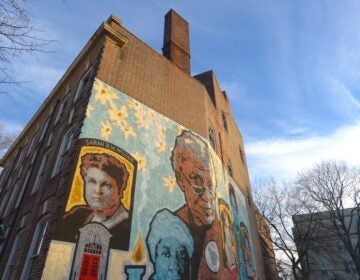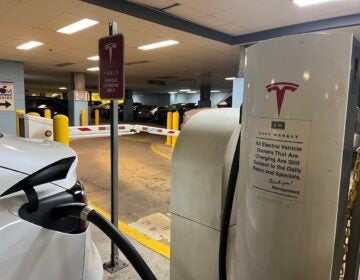First up in a series about Philly’s changing public spaces, Ashley Hahn heads to LOVE Park looking for love and finds plenty. Hear what Philadelphians using the park think about Center City’s newest public space, and what the city says is still to come.
—
It’s 8 a.m. on a bright, breezy Tuesday, and LOVE Park is waking up. At this hour, most of the park is shaded, the green granite is cool, the grass is dewy, and a maintenance worker is unlocking new red cafe tables and chairs, secured together overnight. While the city heads to work, a few people sit in the park, pausing for one more song, or sip, or smoke.
A couple giggles off to one corner, perhaps still tipsy from the previous night, while another toward the middle of the park argues before moving along. Office workers use the wide diagonal walkway as a pass-through. It’s rush hour, but the din of traffic is muffled, even though cars feel more present now that the park’s tall walls are gone. It’s peaceful.
LOVE Park has endured a two-year overhaul, the public-space equivalent of reconstructive surgery, prompted by the need to waterproof the garage below the 2.3-acre expanse. Its clanky stone levels, beloved to skateboarders, and the fountain basin where kids used to splash were peeled away as the park was shaved down to a level plane, gently tilting from City Hall down toward Benjamin Franklin Parkway. The complex project’s budget ballooned to $26 million, from the $16 million projected in 2015.
The hardscape was largely finished last year, and flowering plants have been steadily added in the gardens flanking the two new lawn areas. The garden closest to the LOVE sculpture is already popping with long rows of blooming flowers – yellow yarrow and purple catmint, allium, and sages. Over the last month, crews have finally been finishing off the park’s new concrete benches with wood slat tops, some of which curve around trees like parentheses. Sturdy red tables and chairs now cluster in a young grove.
Just like the plants setting down new roots, Philadelphians are beginning to adjust. And for now, everyone seems to have an opinion about what LOVE Park has become.
Critics have argued the new design succeeded in erasing a vital place and adding hostile features. Inquirer architecture critic Inga Saffron sees in it a “granite Sahara” and a place trying too hard to be multi-functional. Its amenities are viewed as too similar to those at Dilworth or Sister Cities parks nearby, with a paint-by-numbers kit of popular public-space parts, like movable furniture and a splashy water feature.
“Love hurts,” Philadelphia Parks & Recreation Commissioner Kathryn Ott Lovell told me, only half-joking, in early April, when we sat down to talk about the project in her office 10 floors above LOVE Park. But she was quick to say it heals, too.
She hopped up to point out from her window different sections of the park, where more than 50 new trees were starting to leaf out, sod was being replaced, and colorful perennials would soon be added.
Ott Lovell acknowledged that early this spring the park looked really bare, and remembered similar critiques when Dilworth reopened. Since then, its plantings have been augmented, more seating has been added, and people have adapted to new uses of that space.
“Once that fountain goes on and the food trucks come back, we’re going to be slammed. In a good way,” she said, adding that food trucks were planned into the design and would soon be pulling into LOVE Park’s north side for weekday lunches. “We’re going to be ready for heavy use.”
Construction won’t be finished until the end of the year, when the park’s space-age saucer building, the old Fairmount Park Welcome Center, reopens as a restaurant. A new small, glass visitor center will be built, just east of the saucer, to replace its tourist functions. The new kiosk will have a digital screen on its east side facing JFK Boulevard, not unlike the one in Dilworth, to help raise ad revenue for the park.
LOVE Park’s new fountains won’t be turned on until the park’s May 30 grand opening. Programming and food trucks will start back up again soon, too. But as I found out on a recent and spectacularly nice spring day, the park’s unfinished state certainly isn’t stopping people from spending time there.
Over the course of 10 hours, I watched people linger and pass through. I interviewed a diverse cross-section of more than 30 park users: students and suits; retirees and blue-collar workers; tourists and families; caseworkers and parents with court dates. Good reviews outnumbered the bad, and most people had great questions about what they could expect to see in the park next. By the day’s end, it felt a whole lot more like the old LOVE Park to me.
A day in the life of LOVE Park
“I don’t see anything bad about it,” Leroy Fields said, smiling and sitting back in one of the new red chairs. City Hall’s clock had just sounded 10 a.m., and he was among about a dozen people sitting at the park’s new cafe tables.
Fields, a North Philadelphia resident, said he has spent a lot of time in LOVE Park over the years, particularly during his lunch breaks. On this particular Tuesday, he was relaxing before heading across the street to work. He liked that the new park feels more open, which he said is good for safety and even better for people watching.
“I’m not going to get up and dance, but I like looking at the people,” he said, hoping lunchtime events like line dancing make a comeback. “It made me stay longer. It made me bring my lunch over here and eat.”
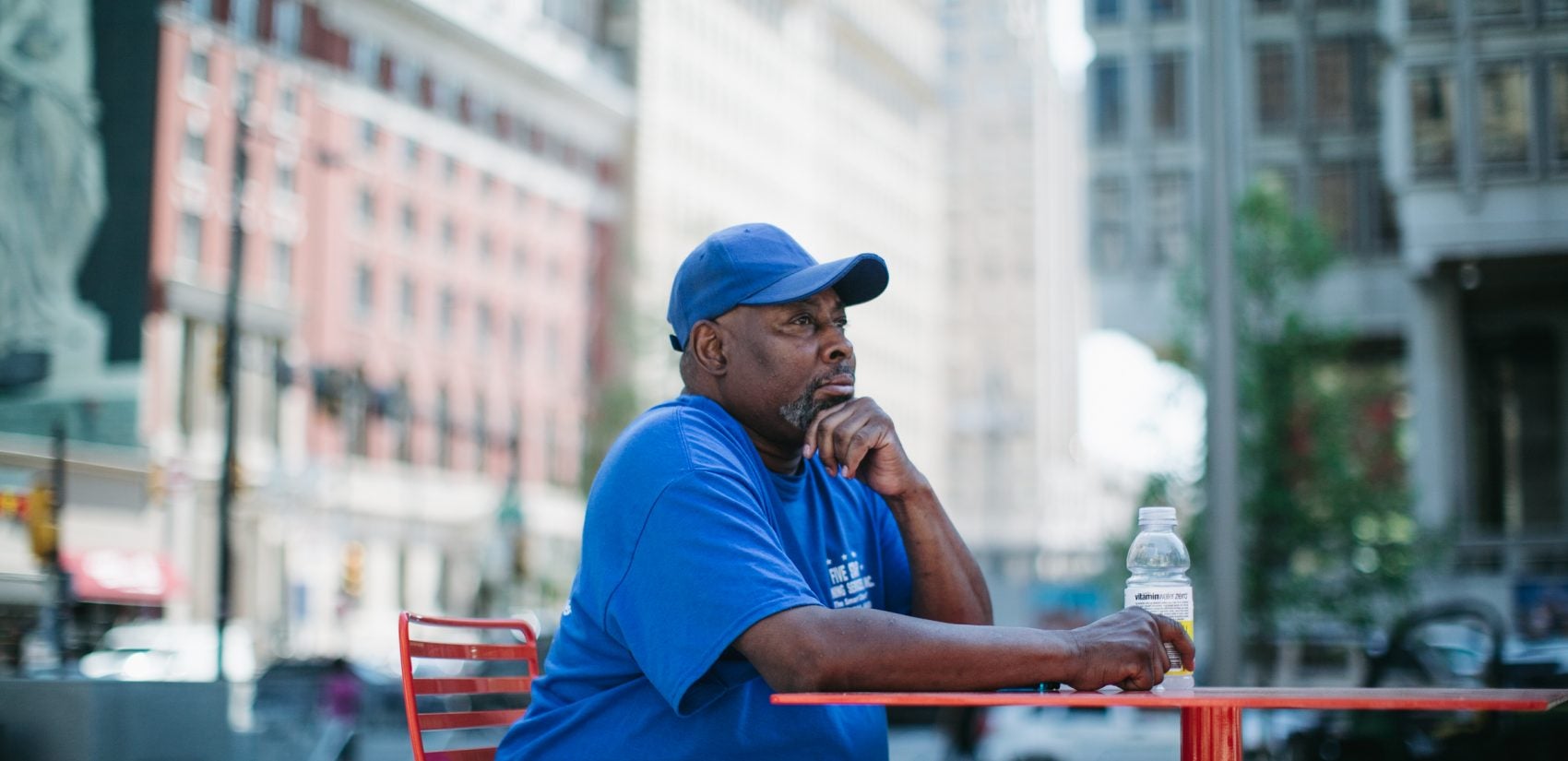
Across the park, Tamika Jacobs, her four daughters, and one daughter’s infant son played on the sunny southern lawn. One of the daughters, Shamerah Owens, had just won a custody hearing in Family Court across the street. The family celebrated with somersaults, cartwheels, and a Wawa picnic on the lawn, having decidedly more fun than anyone else in the park. They agreed that they miss the old fountain but thought the park is a more relaxing space now. Owens delighted as her nine-month-old son Zai’Ray practiced standing up in the grass.
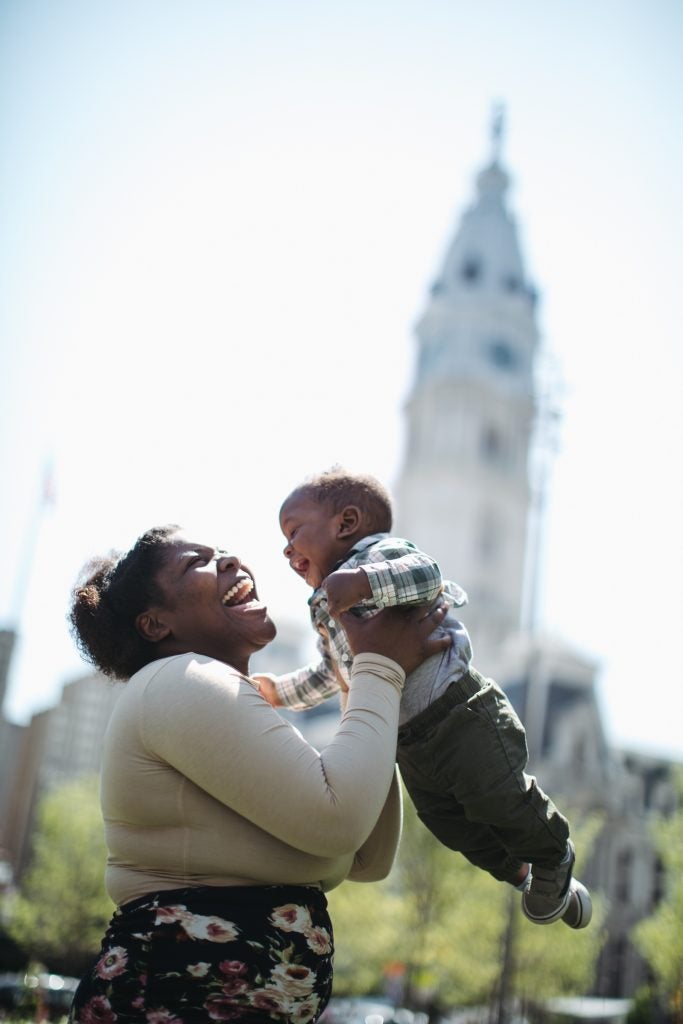
“There used to be so many people here, but now that it’s more open, it’s OK for there to be a lot of people here. There’s more space now,” said Jacobs.
Over by the fountain, bike messenger Scott Flynn leaned against the curved green granite wall – a surprising hangout spot already. He frequently uses this part of LOVE Park as his base and said he likes the new park a lot better than the old one. He recalled it as dingy and full of individuals with no place else to go. There was occasional drug activity, and its fountain only sometimes worked, he remembered.
“It’s more comfortable now, there’s more seating, and it’s just arranged better,” he said, adding that he even prefers the new LOVE Park to Rittenhouse Square because it feels more open.
The park’s early critics bemoaned its seating as inadequate, particularly before the city added cafe sets, 20 tables and 40 chairs so far, and finished the 30 concrete and wood benches, set among trees and at the park’s edges. So upset about the seating were some that a would-be “lawn chair lunch takeover” happened to be called for the day I was spending in the park. Nick Marzano, 36, initiated the BYO seating call (before learning the city would add some) and was one of a few people who showed up with a chair.
He was quick to say it wasn’t a protest, but it’s somehow fitting that one of LOVE Park’s first calls to action would be over its design features.
By midday, LOVE Park was lively. People packed the new benches, tables and chairs. Some perched with their lunches on the short steps at the lawn edges or lounged on the grass. A steady stream of tourists posed for photos at the LOVE sculpture. Nothing felt too crowded, just comfortably active. It was heartening to notice that while some people were nose-deep in smartphone screens, others were enjoying one another’s company or people-watching, the old-fashioned way.
Jason Conner and Abdul-Quadir Islam were drawn partly by the “takeover” and shared a patch of shade on the lawn at lunchtime. They pined for the old LOVE Park.
“I have so many fond memories from my childhood in this park that it’s sort of part of my history as a Philadelphian,” Islam said. “As a child coming to the park, jumping in the fountain, then having my first job across the street from the park, having lunch in the park, to now returning back to Philly after some time away for school to simply find this … flat, barren, crap.”
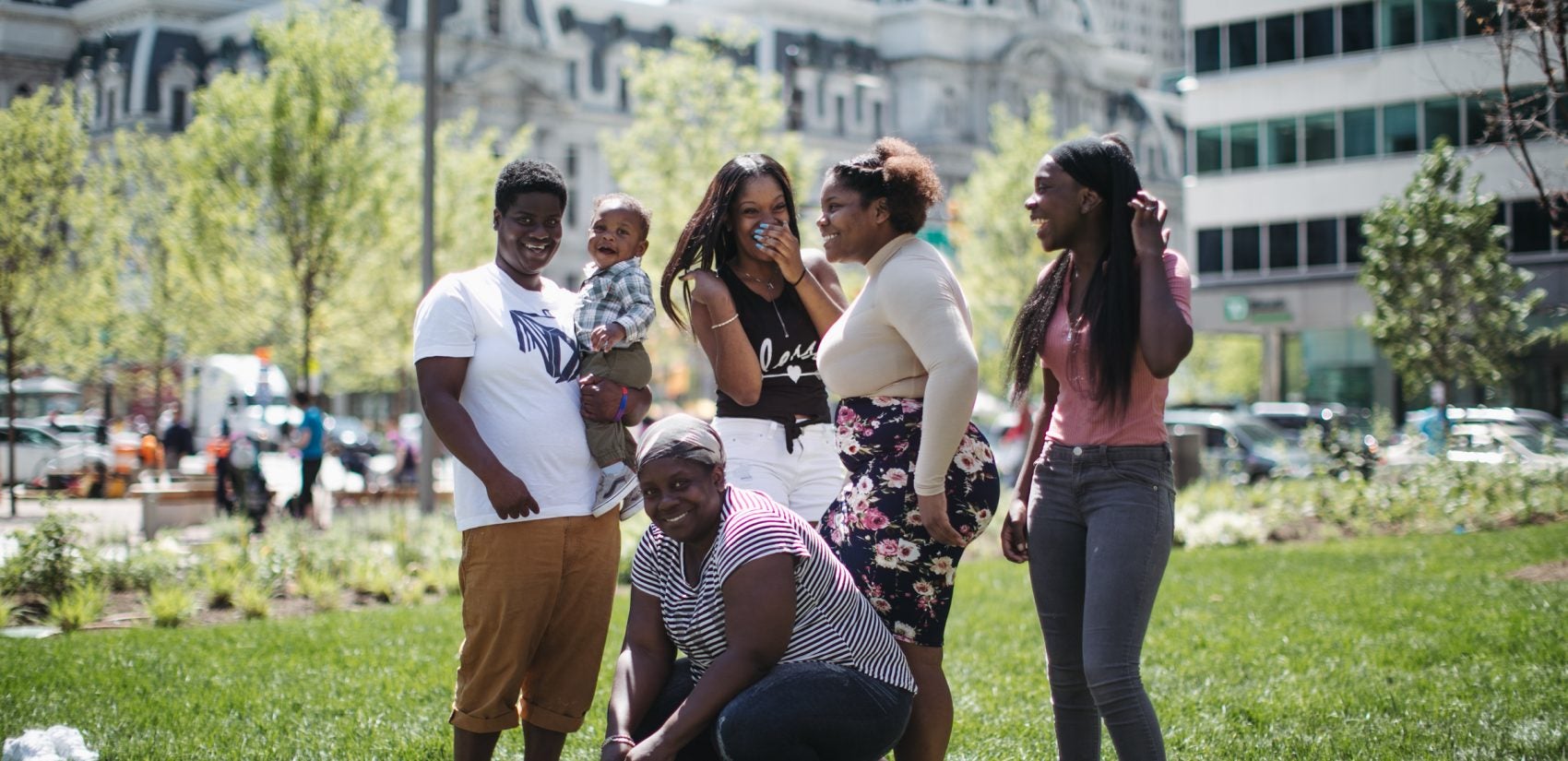
“I feel like they took all the character out of it.” Connor said. “You used to have business executives sitting next to homeless people. And this is probably the only park in the city where that used to happen. Rittenhouse isn’t like that anymore.”
Conner remembered helping organize a demonstration in LOVE Park within a few months of moving to Philly, and has joined many here since then, particularly relating to LGBT issues. He hoped the city will make sure LOVE Park is a place where demonstrations stay at the heart of its identity.
For Islam, the biggest loss was the fountain’s basin, where kids, particularly black and brown youngsters, used to splash. “This acted as an entry place and an access point for them to see themselves in a different community,” he said. “I believe that it will not be the same.”
Others shared some of the same concerns.
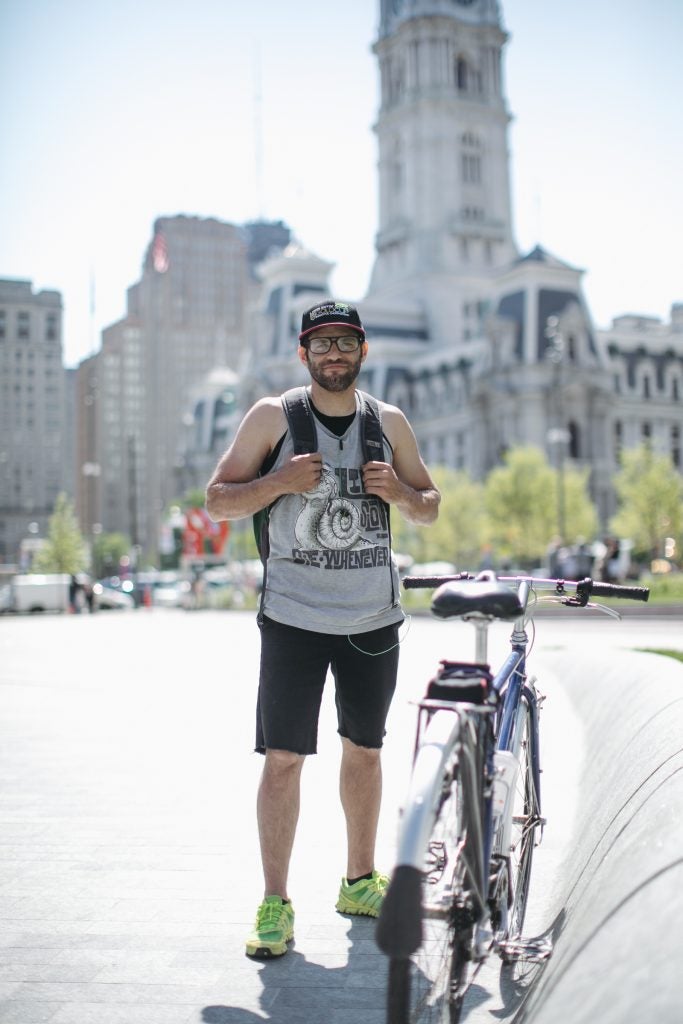
Earlier in the day, Terrell Crumpton, a 29-year-old father of four living in Hunting Park, told me he used to come to LOVE Park daily when he attended Community College of Philadelphia. He would also bring his kids to hang out at the fountain. “They could sit, put their feet in … on a nice breezy day, you could feel the breeze coming off the fountain. It was an amazing feeling. I’m not sure we’ll get the same experience when the fountains come on this summer. I’m waiting to see what that looks like.”
Crumpton was interested to learn the fountain will have two parts, a splashable “bird’s nest” of small jets crisscrossing just below the fountain’s monumental jet on the side toward City Hall.
He suggested more shade, and that amenities like drinking fountains and charging stations be added. “I was thinking, too – now, don’t steal my idea – somebody could rent out lounge chairs like beach chairs.”
Drexel students Valerie Iovine and Erin Egan brought their own lounging gear. Spread out on a blanket studying, they said they come to the park every day now, even feeling comfortable enough to nap with their book bags as pillows. Egan said it was a “perfect” spot.
City employees Josh Lippert and Surj Jones nestled in an inflatable lounge chair, enjoying the sunshine and grass. Jones said she appreciated how green the park has become, which she finds soothing. But Lippert said it felt too edgeless and exposed. The flatness makes the park accessible, but takes away any sense of enclosure the old park had.
On the day I was there, the crowd thinned by mid-afternoon. Without too much in the way of shade, the sun beat down, making the park feel hotter than it probably was, and the few shady spots were occupied.
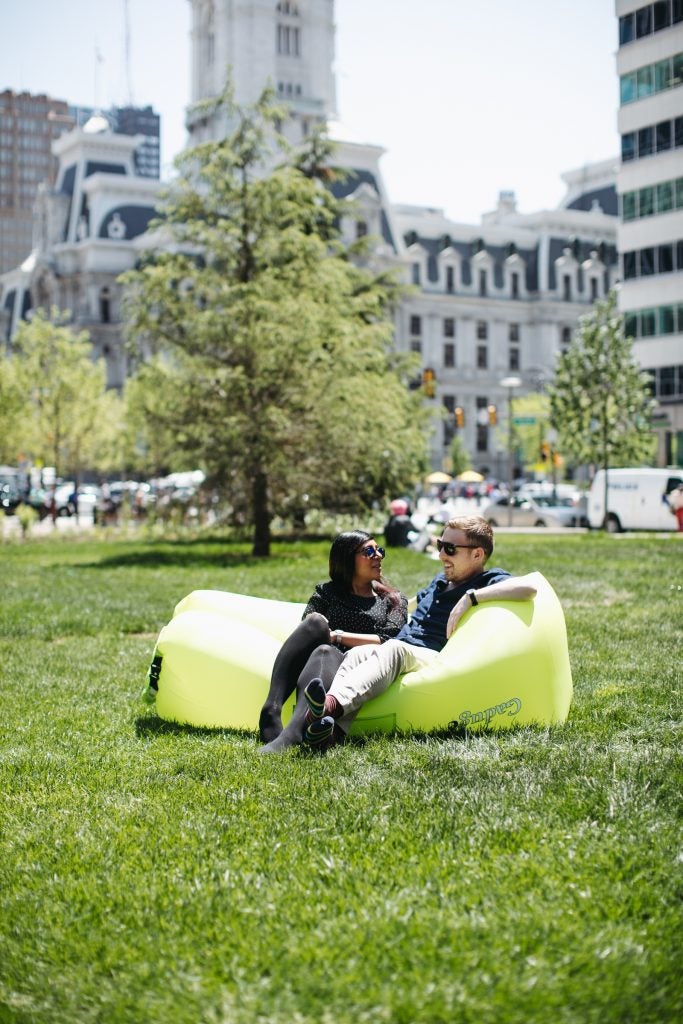
Marge Palmer, a senior citizen who lives in North Philly, improvised by pulling a red metal chair into a patch of shade. She set her bags on a bench in the corner of the new tree grove, sat down for a snack, and took in the new park for the first time. Years ago when she worked for Conrail, Palmer said, she would come through LOVE Park frequently. More recently, during her years living in a shelter, she would come to the park when religious groups would give out donations of food or clothing and churches would pick people up to attend services. She marveled at seeing the park’s new look.
“It gives me hope. Life goes on. It don’t stop, it just continues, and it’s just terrific. It really is. I think this is adorable because as the trees blossom you’re going to get more shade. It’s great for tourism … it’s wonderful for the people who work here. They can have lunch here and sit down, chat for a few minutes before going back to the office, rejuvenate and revitalize.”
“It feels great. I am so glad they got it back,” Palmer said. “I just love LOVE Park.”
By late afternoon, the park’s pace slowed even more. People sat in the grass reading quietly. Students met for a study group, sitting by the fountain. But as the shadows grew long, activity again picked up. Streams of people passed through, some leaving work, others exercising.
As the sun sank and buildings began to shade the park again, the fountain and the LOVE sculpture shared a shrinking shaft of light. Some young people did a photo shoot, dancing on a bench to a Phil Collins song blasting from a passing car, and at one point a lithe young woman precariously perched on top of the new fountain. Two women put a pink blanket down on the grass and watched the world go by.
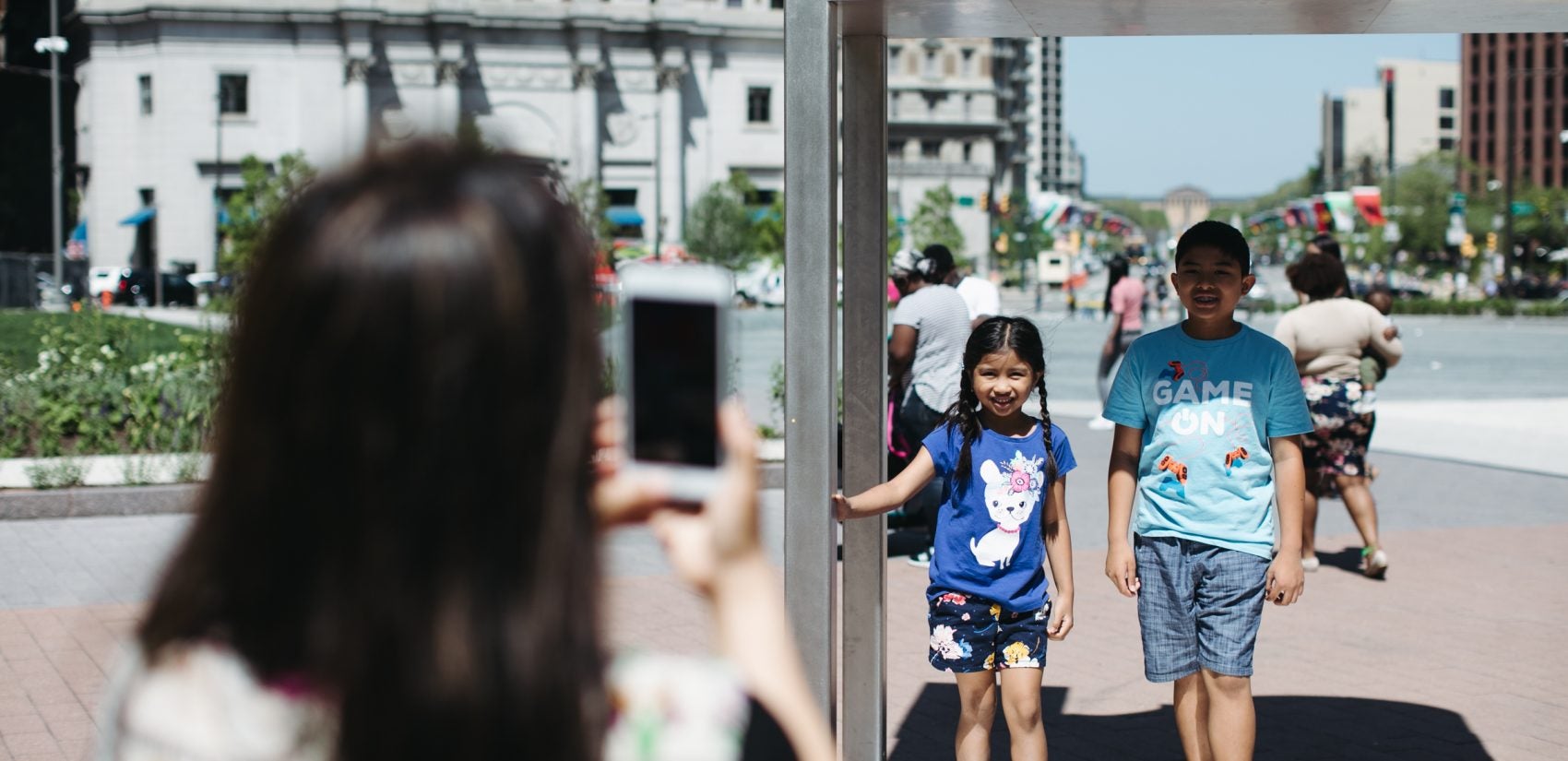
Searching for a real LOVE
Our experiences of LOVE Park will keep shifting as construction finishes this year, as new programs are tested, and as Philadelphians determine their own ways of using the park.
On May 30, the fountains will go on, and the park’s renovation will be celebrated with a VIP – “Very Important Park” –fundraiser hosted by the Friends of LOVE Park, a new group incubated by the Fairmount Park Conservancy. The group’s primary focus will be to raise money from neighboring companies and donors. So far, more than $1 million has been raised from a variety of sources to support capital projects, as well as a high level of programming and maintenance – work the city’s budget cannot and should not be expected to cover alone.
Unlike Dilworth Park, which is managed by Center City District, LOVE Park will remain a city-managed public park. In addition to two maintenance employees slated to staff the park, Ott Lovell said, there will be a ranger, a night watchman, and an attendant for the public restroom that will be below the restaurant. Center City District is pitching in to help clean LOVE Park, and its teal-jacketed ambassadors will pass through too.
Fairmount Park Conservancy is managing the saucer’s renovation, helping to raise funds, and collaborating on new programs for the park. Jamie Gauthier, the conservancy’s executive director, said it is thinking about organizing arts and cultural events that will help Philadelphians define LOVE Park’s new identity.
“We want to keep its feel of authenticity … that feel of it representing people from all over the city, and infuse that into the programming,” Gauthier said. “Part of the idea would be to bring in artists from all different neighborhoods and corners of our city to display their art, display our city’s culture, do live performances, and show what our city is all about in this space.” FringeArts, for starters, is working with the conservancy to use LOVE Park as a venue during this fall’s Fringe Festival.
Most of the time, LOVE Park will be a passive space, Ott Lovell said, but weekday programs will return soon, each with what she described as love-related themes. Ideas so far include: Mindfulness Mondays, a day to “love yourself” with tai chi or yoga; “love your life” with dancing on Fridays; and her personal passion project, Wedding Wednesdays, a day to “love each other.”
There, Ott Lovell sees potential in the park never before realized or perhaps even imagined: Love Park as a wedding hotspot.
“Ash, have you ever been to a Sandals?” Ott Lovell asked me, referring to the chain of Caribbean resorts where wedding packages represent a steady stream of business. (I have not.)
“When you sit on the beach at Sandals, at the right time of year, just reading your magazine catching some rays, and over to your left there’s an altar with flowers. And every 15 minutes, someone gets married. You’re basically right there. And my husband, it freaked him out a little bit. But for me, it was like watching the ‘Wedding Story’ on rotation while I sat on the beach. And I thought it was amazing. And so wouldn’t it be amazing if every Wednesday you knew you could come and see four couples get married? And where do people get married? In City Hall. So if you want to get married in Love Park, maybe pay a little more?”
In a way, Ott Lovell said, it reminds her of her own wedding story. A month before she got married, her girlfriends took her on a blindfolded tour of places meaningful to her all over the city. “We ended up at the ‘LOVE’ sculpture. My fiancé, my husband now, was standing there with roses for me. That was the end of my little bachelorette tour. I have this great picture of me crying and him being there. It was just amazing … We all have those LOVE Park stories.”
These are the kinds of experiences that make public spaces beloved, and that make them feel ours. This kind of relationship needs time to develop. Just like the park needs to heal from construction and its trees need a few seasons to fill out, the public needs time to adapt, too. We need room to make new memories and figure out just what we want from our new LOVE.
Recent disappointment over LOVE Park’s redesign made me think about how much we’ve had to be lured back into public space, spoon-fed with programming and recognizable features like cafe sets. But design was hardly what made the old LOVE Park successful. It was crowded and busted, but it supported an incredibly intricate and diverse public life. We were LOVE Park’s beating heart.
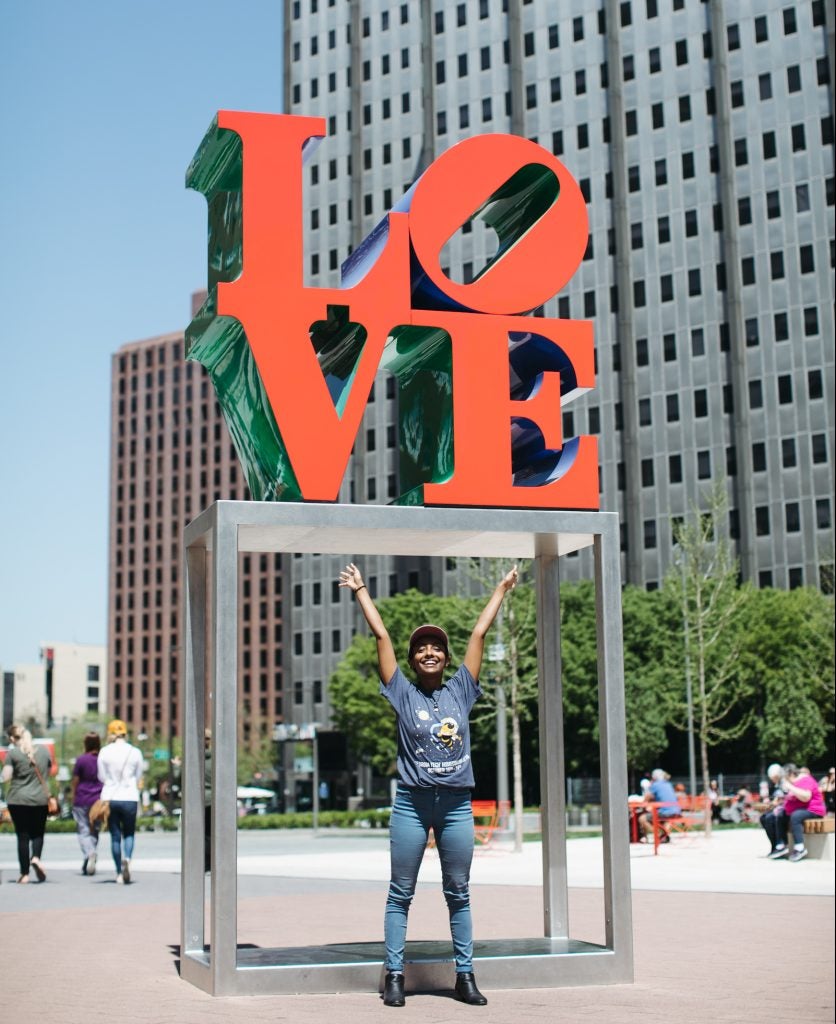
And Philadelphians did have their say about LOVE Park’s future through an extensive civic- engagement process. From September 2014 to January 2015, PennPraxis collaborated with the Penn Project for Civic Engagement and Fairmount Park Conservancy gathering public input to inform the Hargreaves Associates redesign. Hundreds of people participated in facilitated meetings and talked to planners who spent days collecting ideas in the park. At the time, PlanPhilly was a project of PennPraxis and followed the process closely. Back then, I wrote that the new LOVE should be built on old strengths, in particular, that the new park should be designed to support free expression, to seriously entertain the saucer’s reuse potential, and to support a rich diversity of use. Those ideas were adopted into the new design.
Hargreaves designed the new LOVE Park as a greener place, with more seating and open areas, all given high priority by the participating public. The designers also preserved the strong diagonal axis, with Robert Indiana’s “LOVE” sculpture and a major water feature in roughly the same spots. What LOVE Park may currently lack in whimsy, it makes up for in sturdy materials selected to withstand heavy use, which was a priority for the city.
It’s not the arrangement of furniture or a fountain that will make LOVE Park sing. Design matters. But time and lived experiences construct public spaces just as profoundly. In the great theater of public life, design sets the stage, plantings and furniture are the props, and collectively we get to write the script.
—
In Common is made possible through support from the John S. and James L. Knight Foundation.
WHYY is your source for fact-based, in-depth journalism and information. As a nonprofit organization, we rely on financial support from readers like you. Please give today.







